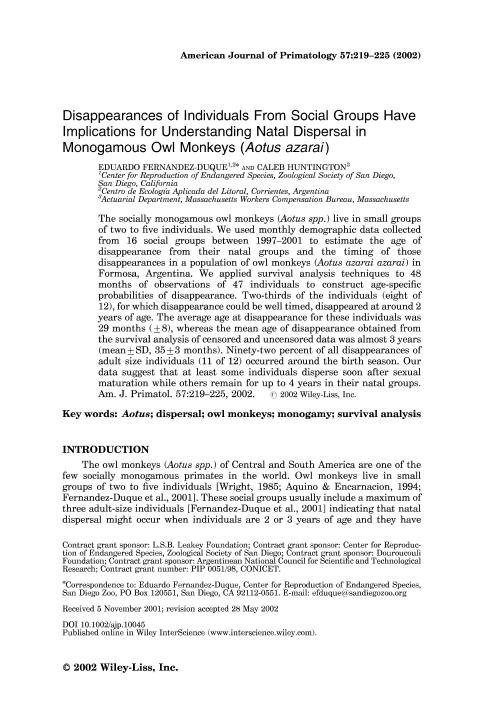Artículo
Disappearances of individuals from social groups have implications for understanding natal dispersal in monogamous owl monkeys (Aotus azarai)
Fecha de publicación:
08/2002
Editorial:
Wiley-liss, Div John Wiley & Sons Inc
Revista:
American Journal Of Primatology
ISSN:
0275-2565
Idioma:
Inglés
Tipo de recurso:
Artículo publicado
Clasificación temática:
Resumen
The socially monogamous owl monkeys (Aotus spp.) live in small groups of two to five individuals. We used monthly demographic data collected from 16 social groups between 1997-2001 to estimate the age of disappearance from their natal groups and the timing of those disappearances in a population of owl monkeys (Aotus azarai azarai) in Formosa, Argentina. We applied survival analysis techniques to 48 months of observations of 47 individuals to construct age-specific probabilities of disappearance. Two-thirds of the individuals (eight of 12), for which disappearance could be well timed, disappeared at around 2 years of age. The average age at disappearance for these individuals was 29 months (± 8), whereas the mean age of disappearance obtained from the survival analysis of censored and uncensored data was almost 3 years (mean±SD, 35±3 months). Ninety-two percent of all disappearances of adult size individuals (11 of 12) occurred around the birth season. Our data suggest that at least some individuals disperse soon after sexual maturation while others remain for up to 4 years in their natal groups. © 2002 Wiley-Liss, Inc.
Palabras clave:
Aotus
,
Dispersal
,
Monogamy
,
Owl Monkeys
,
Survival Analysis
Archivos asociados
Licencia
Identificadores
Colecciones
Articulos(CECOAL)
Articulos de CENTRO DE ECOLOGIA APLICADA DEL LITORAL (I)
Articulos de CENTRO DE ECOLOGIA APLICADA DEL LITORAL (I)
Citación
Fernandez Duque, Eduardo; Huntington, Caleb; Disappearances of individuals from social groups have implications for understanding natal dispersal in monogamous owl monkeys (Aotus azarai); Wiley-liss, Div John Wiley & Sons Inc; American Journal Of Primatology; 57; 4; 8-2002; 219-225
Compartir
Altmétricas




